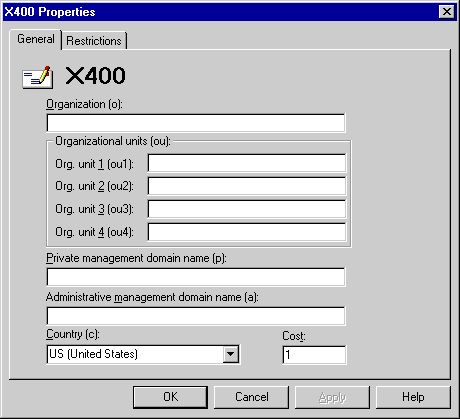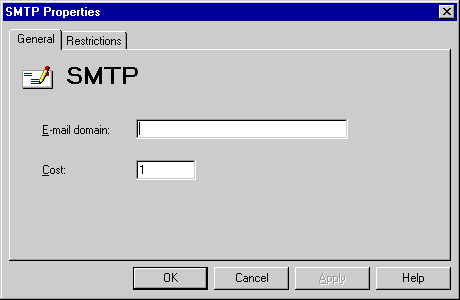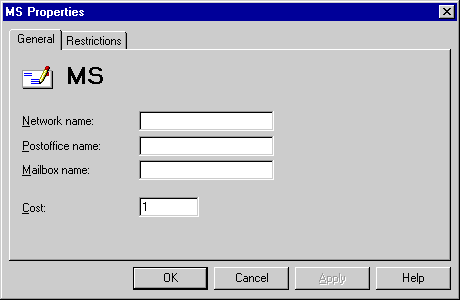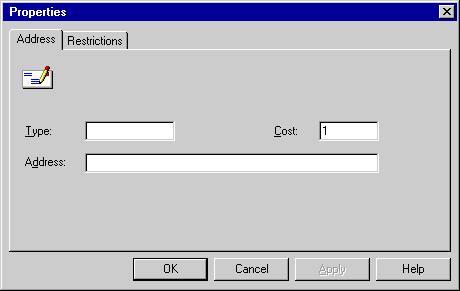
| Operations | << | >> |
|---|
The General property page for each address space type is a template to help you create address spaces. You can choose templates to create X.400, Internet (SMTP), Microsoft Mail, and other address spaces.
The cost associated with each address space is used to optimize outbound message routing but does not affect message reception. Routing costs range from 1 to 100. Lower cost routes take precedence over higher cost routes. If two or more routes are available with the same cost, the load placed on the routes is roughly equal.
For more information about routing costs, see Microsoft Exchange Server Concepts and Planning.
Use the General property page as a template to create an X.400 address space.
Note An asterisk (*) can be used for a multicharacter wildcard in an address space. A percent symbol (%) can be used for a single character wildcard.

An X.400 address space contains the following information:
| Address attribute | Description |
|---|---|
| Organization (o) | 0 through 64 characters. |
| Org. unit 1 - 4 (ou1 - ou4) | 0 through 32 characters. |
| Private management domain name (p) | 1 through 16 characters. |
| Administrative management domain name (a) | 1 through 16 characters. |
| Country (c) | 2 characters or 3 digits. |
| Cost | A value from 1 to 100. Lower cost routes take precedence over higher cost routes. |
The characters you use can vary according to the character set used by the connected system. However, characters must be printable strings. Address components are not case-sensitive, but case is preserved.
Use the General property page as a template to create an Internet (SMTP) address space.
Note An asterisk (*) can be used for a multicharacter wildcard in an address space. A percent symbol (%) can be used for a single character wildcard. Therefore, the percent symbol is not available for use as a character in the SMTP address.

An Internet (SMTP) address space contains the following information:
| Address attribute | Description |
|---|---|
| E-mail domain | 1 through 255 alphanumeric characters composed of one or more domain labels (up to 63 characters each), typically in the format sitename.enterprisename.domain_suffix. Use an asterisk (*) to indicate subdomains. An ending asterisk (*) is appended to the address space, but is not displayed. |
| Cost | A value from 1 to 100. Lower cost routes take precedence over higher cost routes. |
For more information about routing costs, see Microsoft Exchange Server Concepts and Planning.
Use the General property page as a template to create a Microsoft Mail address space.
Note An asterisk (*) can be used for a multicharacter wildcard in an address space. A percent symbol (%) can be used for a single character wildcard.

A Microsoft Mail address space contains the following information:
| Address attribute | Description |
|---|---|
| Network name | 1 through 10 capital alphanumeric characters. |
| Postoffice name | 1 through 10 capital alphanumeric characters. |
| Mailbox name | The postoffice mailbox name on the remote Microsoft Mail system that you want to connect to. |
| Cost | A value from 1 to 100. Lower cost routes take precedence over higher cost routes. |
For more information about routing costs, see Microsoft Exchange Server Concepts and Planning.
You can configure an address type for which there is no template. Enter as much information as necessary to distinguish messages that should be sent through the connector.
Note An asterisk (*) can be used for a multicharacter wildcard in an address space. A percent symbol (%) can be used for a single character wildcard.

When creating a general address space entry, you should consider the following:
fax!+19085551234 (/James Braun) /delivery
A general address space contains the following information:
| Address attribute | Description |
|---|---|
| Type | A set of unique alphanumeric characters that identifies the system. |
| Address | A set of alphanumeric characters. |
| Cost | A value from 1 to 100. Lower cost routes take precedence over higher cost routes. |
For more information about routing costs, see Microsoft Exchange Server Concepts and Planning.